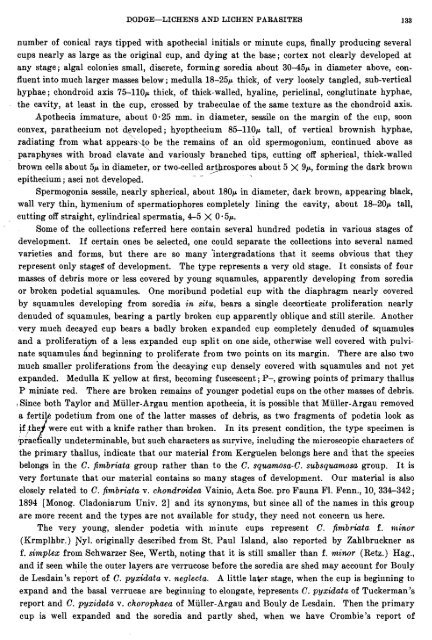Create successful ePaper yourself
Turn your PDF publications into a flip-book with our unique Google optimized e-Paper software.
DODGE-<strong><strong>LICHEN</strong>S</strong> <strong>AND</strong> <strong>LICHEN</strong> <strong>PARASITES</strong> 133<br />
number of conical rays tipped with apothecial initials or minute cups, finally producing several<br />
cups nearly as large as the original cup, and dying at the base; cortex not clearly developed at<br />
any stage; algal colonies small, discrete, forming soredia about 30-4jr. in diameter above, con-<br />
fluent into much larger masses below ; medulla 18-25p thick, of very loosely tangled, sub-vertical<br />
hyphae; chondroid axis 75-11OP thick, of thick-walled, hyaline, periclinal, conglutinate hyphae,<br />
the cavity, at least in the cup, crossed by trabeculae of the same texture as the chondroid axis.<br />
Apothecia immature, about 0.25 mm. in diameter, sessile 011 the margin of the cup, soon<br />
convex, parathecium not qeveloped; hyopthecium 85-110p tall, of vertical brownish hyphae,<br />
radiating from what appearsqo be the remains of an old spermogonium, continued above as<br />
paraphyses with broad clavate 'and variously branched tips, cutting off spherical, thick-walled<br />
brown cells about 5p in diameter, or two-celled ar9rospores about 5 X gr, forming the dark brow11<br />
-<br />
epithecium ; asci not developed.<br />
Spermogonia sessile, nearly spherical, about 180p in diameter, dark brown, appearing black,<br />
wall very thin, hymenium of spermatiophores completely lining the cavity, about 18-20p tall,<br />
cutting off straight, cylindrical spermatia, 4-5 X 0.5p.<br />
Some of the collections referred here contain several hundred podetia in various stages of<br />
development. If certain ones be selected, one could separate the collections into several named<br />
varieties and forms, but there are so many 'intergradations that it seems obvious that they<br />
represent only stage# of development. The type represents a very old stage. It consists of four<br />
masses of debris more or less covered by young squamules, apparently developing from soredia<br />
or broken podetial squamules. One moribund podetial cup with the diaphragm nearly covered<br />
by squamules developing from soredia in situ, bears a single decorticate proliferation nearly<br />
denuded of squamules, bearing a partly broken cup apparently oblique and still sterile. Another<br />
very much decayed cup bears a badly broken expanded cup completely denuded of squamules<br />
and a proliferatipn of a less expanded cup split on one side, otherwise well covered with pulvinate<br />
squamules And beginning to proliferate from two points on its margin. There are also two<br />
much smaller proliferations from 'the decaying cup densely covered with squamules and not yet<br />
expanded. Medulla K yellow at first, becoming fuscescent ; P-, growing points of primary thallus<br />
P miniate red. There are broken remains of younger podetial cups on the other masses of debris.<br />
,Since both Taylor and Muller-Argau mention apothecia, it is possible that Muller-Argau removed<br />
a fertili:<br />
i<br />
podetium from one of the latter masses of debris, as two fragments of podetia look as<br />
if ,the were cut with a knife rather than broken. In its present condition, the type specime~z is<br />
~prac ically undeterminable, but such characters as survive, including the microscopic characters of<br />
the erimary thallus, indicate that our material from Kerguelen belongs here and that the species<br />
belongs in the C. fimbriata group rather than to the C. squamosa-C. subsquamosa group. It is<br />
very fortunate that our material contains so many stages of development. Our material is also<br />
closely related to C. fimbriata v. chondroidea Vainio, Acta Soc. pro Fauna F1. Fenn., 10, 334-342;<br />
1894 [Monog. Cladoniarum Univ. 21 and its synonyms, but since all of the names in this group<br />
are more recent and the types are not available for study, they need not concern us here.<br />
The very young, slender podetia with ir~inute cups represent C. fimbriata, f. minor<br />
(Krmplhbr.) yyl. originally described from St. Paul Island, also reported by Zahlbruckner as<br />
f. simplex from Schwarzer See, Werth, noting that it is still smaller than f. minor (Retz.) Hag.,<br />
and if seen while the outer layers are verrucose before the soredia are shed may account for Bouly<br />
de Lesdain's report of C. pyxidata v. neglecta. A little later stage, when the cup is beginning to<br />
expand and the basal verrucae are begii~iiiilg to elongate, kepresents C. pyxidata of Tuckerman's<br />
report and C. pyxidata v. chorophaea of Muller-Argau and Bouly de Lesdain. Then the primary<br />
cup is well expanded and the soredia and partly shed, when we have Crombie's report of

















